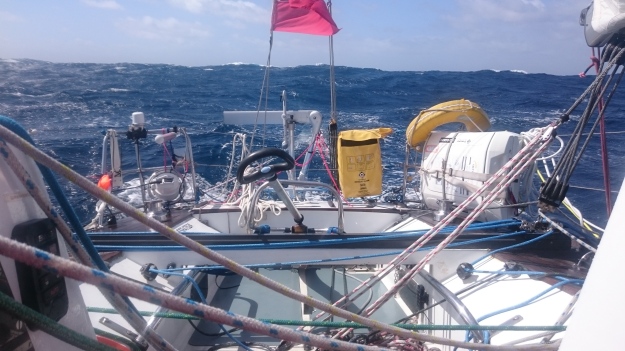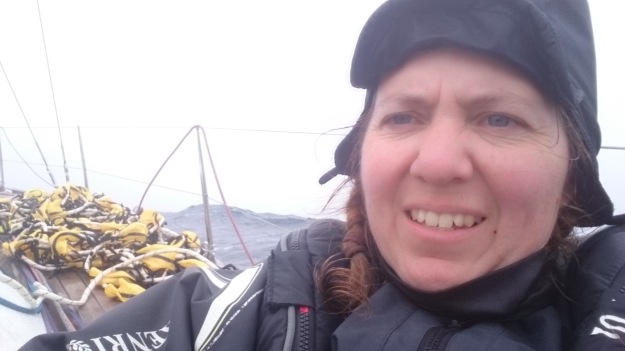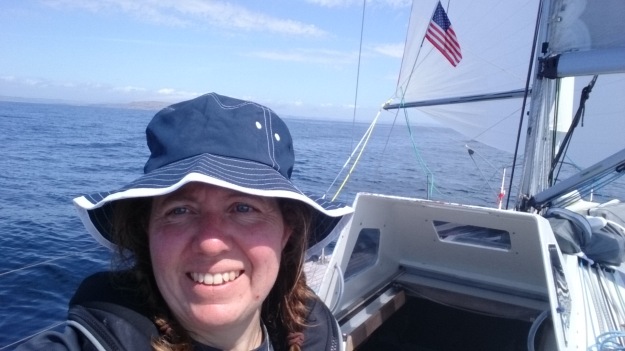By far the question I am most frequently asked these days is “why did you retire from the OSTAR?” Indeed, I seem to ask myself that very question every morning when I wake up and remember what’s happened. I’m still working on a full written account of my entire race, but in the meantime I’d like to have a go at answering this most pressing of questions. I highly recommending having a look at an animated replay of the race on the Official YB Tracker, being sure to enable the weather layer when you do so.
I made the decision to retire on June 11, after 13 days of racing. I was about halfway across open Atlantic, but had only covered about a third of the distance of the course. Two unlikely events meant I was right at the end of the chain of redundancy of the essential systems on board – an engine problem and a broken linkage in the wind vane steering. The latter had been intended as the ultimate backup – a robust mechanical device that doesn’t depend on electricity, or input from the boat’s instrument systems.
Nevertheless I had just weathered the worst storm in the race’s history, an uncharacteristically severe and unseasonable depression with a surface pressure at its centre of 965 mb, a full 14 millibars lower than the infamous ’79 Fastnet storm. Of the sixteen OSTAR/TWOSTAR boats still racing when the storm hit, only seven managed to finish the race. Four boats sank with all hands rescued and the remaining five (including Zest) retired and made it to safety without assistance. For the weather geeks among you, I provide the Met Office’s surface pressure analyses for the Atlantic during the relevant period, with Zest’s approximate position marked on each one.
I think my success at getting through the storm relatively unscathed was mostly down to my taking early and decisive action to avoid being in the worst of the wind and waves. Even with the few days’ warning I had, I was never going to be able to outrun this monster, so the next best thing was to try to stay on its good side. And good side is very much a relative term here, I recorded a surface pressure down to 978mb and saw gusts up to 51 knots. As for wave heights I’m afraid I can’t be as precise, but they were easily as big, on average, as what I experienced the night Zest was dismasted by a rogue wave off the coast of Spain in 2015, which is to say a significant wave height of about 4m.
In any case, the waves on first night of the storm were big enough to cause a 90 degree knockdown which resulted in the engine oil I had found in the bilge under the engine on day 2 (more on what it was doing there later) getting distributed over a large portion of the interior surfaces. The wind suddenly moderated to 15 knots around 5am and then continued to die away until I was left becalmed in a large slop for most of the afternoon. I spent the day cleaning up the mess caused by the knockdown and trying to rest up in preparation for act two of the storm. The cleaning bit entailed hours of sliding around on my behind on the oil-covered cabin sole, desperately trying to get the floorboards clean enough that it would be safe to stand up on them and move around without looking like a character in some old slapstick comedy.
As the wind came up again in the small hours of June 10 we were experiencing fast but seemingly controlled surfing conditions, but as the mean wind strength topped 40 knots with little sign of moderating, I started to worry that we were approaching the area containing the worst sea state rather too quickly (a fear that was later shown to be well justified, as that’s where both Tamarind and Happy met the conditions that caused them to sink). That was when I decided to apply the brakes by deploying the Jordan Series Drogue. I would end up spending roughly 36 hours lying to the drogue, which was attached to a bridle which was in turn connected to chainplates on either quarter.

Untidy cockpit of Zest as she lay to her Jordan Series Drogue during the 2017 OSTAR
I found this, my first ever experience with a drogue, to be a mixed bag. It was great to be able the leave the boat largely to her own devices as she drifted slowly downwind, but it was far from relaxing. We were constantly buffeted by waves from many directions, the worst being the ones from directly behind which, on several occasions, sent gallons of seawater firehosing through the tiny gaps between and around the washboards, much of it landing on the chart table and making me fear for the electronic navigation and communication systems.
Actually, on second thought, the worst waves were the big breaking monsters I could hear approaching from a distance, each one reminding me of the one that dismasted us, and how things can go from ‘okay’ to ‘game over’ in a matter of seconds. This was torture and I’d had enough, I decided I would retire. But as the wind and waves eventually moderated, and after as good a night’s sleep as it’s possible to get in those circumstances, I felt more positive and willing to continue racing. It was only when I started to bring the drogue in that I noticed something that tipped the balance back towards retiring –damage to my windvane steering. Somehow in the course of the storm an essential component made of stainless steel had sheered off. It was not something I could repair onboard.

With the drogue successfully recovered, I pause for a selfie.
My windvane steering system was installed to provide a backup in case my main autopilot failed or I lost the ability to generate power for the batteries. Happily my main autopilot was still working, but I had lost my primarily means of generating power on day 2 of the race, when the engine packed up thanks to all the oil falling out of it [^1]. I had been able to get by without the engine thanks to a combination of a 100W solar panel and a towed hydrogenerator (affectionately known as ‘the Toad’), but the loss of my windvane steering left me feeling particularly vulnerable. If the tow line for the turbine broke and I lost that then I would not have enough power to run the main autopilot, and I would have to ration my use of my navigation and communications equipment.
I also considered the implications of the loss of propulsion. If I needed the engine to get out of a dangerous situation, particularly in a calm, such as an imminent collision or drifting onto shoals I would be out of luck.
I ran a routing for the remainder of the race and found that it would take me at least another two weeks and I would have to sail through another two depressions to get to the finish. As this would take me well past my maximum estimated duration of the race, freshwater might become an issue (food would not have been an issue, as I’d over provisioned by a silly margin). Finally, I had to consider that fact that I was doing the OSTAR with the minimum required insurance cover, which is to say, third party only, as I, like many of my competitors, had been unable to obtain a quote for comprehensive coverage. If I were to lose the boat there would be no compensation.
So, taken all together, I felt it was just too risky for me to continue. Sure, there had been competitors in past editions who had overcome similar setbacks, but my guess is that in most cases they had little choice but to press on. I quite likely would have survived and possibly triumphed. Indeed, to have simply finished this edition of the race would have placed me firmly amongst the legends of the OSTAR, which would have been a thrill, but there was still a non-negligible chance that it could have gone horribly wrong. It was just not worth it to me, and not fair to put Rupert, my family, my friends and the race committee through the additional stress. And so, with huge regret, I changed course and headed for Kinsale in Ireland, a week’s sail downwind.

Six days after retiring, I arrived safely in Kinsale, Ireland.
The second most frequently asked question I hear these days is “will you do the OSTAR again?”. The answer to that is much more straightforward: yes. Health and wealth permitting, I will be on the start line for OSTAR 2020, keeping on with Zest.
[^1]: How does this even happen? In addition to the dipstick, my engine has a small pipe leading out of the oil sump for the purpose of facilitating oil changes. It was rather flimsy and unsupported, so it was our policy not to use it. What we failed to consider was that it may have already had 20 years of use and weakening before I bought the boat. Hindsight, and all that. The odds of it breaking off at the start of my biggest event? Tiny, I’m sure…maybe as slim as the possibility of being hit by a rogue wave or the ‘storm of the century’. I am learning not to be surprised by any of this.
